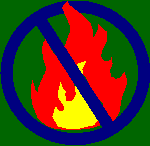
This Site © Copyright 1998 EBFRIP
13 October 1998 Integrating the environmental impact of consumer product fires into life-cycle assessments
Life-cycle assessments (LCAs) of consumer products such as television sets and personal computers currently do not consider the environmental impact of fires involving such products. In so doing, LCA practitioners ignore the reduced environmental impact of products, which benefit from increased resistance to fires through the use of flame-retardant chemicals.
A recent study has shown that most of today's (new) TV sets on the European market are far less fire resistant than their counterparts in the US and Japan. TV set fires in the Netherlands, the UK and Sweden, where detailed statistics are available, show signs of increasing. In light of this it is important that one considers the environmental impact of flame retardants from a holistic point of view.
LCA methodology is in itself a complex model for weighing up different parts of a given product's whole life-cycle - from the cradle to the grave. Now that much of the LCA methodology has been defined internationally it is timely to add new finesses, such as the inclusion of accident analysis. The increased potential fire risk in the absence of flame retardants can be calculated using statistics. This, combined with measurements from full size fire tests allows the assessment of the environmental effect of flame retardants from a broader perspective than previously possible.
In this three-year programme, the initial focus is on TV sets. The LCA dimension to the programme will be carried out by the Swedish Environmental Research Institute (IVL), which will base its calculations on internationally recognised LCA methodology.
A preparatory study has been completed on details of the LCA model and the method for employing fire statistics to determine the effect of a higher level of fire safety on fire emissions. The results are summarised in an SP Report, no. 1998:25, which can be ordered from the project leader directly.
Programme sponsors so far include the European Flame Retardants Association (EFRA) and its equivalent in the US (FRCA) and Japan (FRCJ), as well as the European Brominated Flame Retardant Industry Panel (EBFRIP).
For further information, please contact
Dr Margaret Simonson at:
tel.: +46 33 16 50 00; fax: +46 33 41 60 12; Email: [email protected];
SP Web Site: http://www.sp.se/fire/source/research.htm
